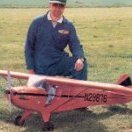-
Posts
10,227 -
Joined
-
Last visited
-
Days Won
18
Simon Chaddock last won the day on May 13 2023
Simon Chaddock had the most liked content!
Recent Profile Visitors
Simon Chaddock's Achievements
1.1k
Reputation
-

Quarter Scale V12 Merlin motor
Simon Chaddock replied to Terry Plumridge 1's topic in All Things Model Flying
It sounds terribly quiet for a engine with a total capacity of 421cc (27 litre/4x4x4) making each cylinder 35cc and on open exhausts. Just and observation. -

An RC Depron Douglas X3 Stiletto
Simon Chaddock replied to Simon Chaddock's topic in Own Design Project Blogs
Now all back together. Hole? What hole. A new "heavy" nose cone printed in double wall PLA rather than a single wall in LW-PLA. It also has 5g of lead in it so 13g rather than2. The CofG is now still further forward. It looks crazy but it flew impossibly tail heavy at the left hand mark (25% mean chord). Still flew tail heavy at the middle mark (18%). The right hand mark is at about 12%. I just have to accept that the long relatively bulky forward fuselage compared to the tiny wing creates a substantial nose up pitch at the normal angle of attack for such a light weight low powered plane. The final modification will be to cut down the full span ailerons as the roll sensitivity is much too great. Even the gyro can't control it at the moment. -
"Big temperature change" is an important point. The maximum charge a LiPo can accept is affected by temperature. They don't like the cold. A fully charged LiPo at 20 degrees will become over charged if allowed to drop to say 5 degrees. The damage done to the capacity of the cells in this situation may only be a small proportion of the total but it is permanent. If it is repeated the damage is cumulative. Unless you can be sure the temperature is kept constant it is a valid reason, apart from any safety concerns, not to leave a LiPo fully charged for any longer than necessary.
-

An RC Depron Douglas X3 Stiletto
Simon Chaddock replied to Simon Chaddock's topic in Own Design Project Blogs
I already has a Lemon 3 axis stabiliser Rx fitted although with no rudder the yaw is not connected. It was the rapid rolling from side to side which is a classic symptom of an over sensitive roll gyro. However the roll sensitivity "pot" is set to the mid point which suggests the ailerons themselves are far to powerful. My favoured solution is not to limit their travel but make them a good bit smaller in area. The replacement nose cone will be printed in PLA rather than LW-PLA which will add 3g. No much but it is along way forward. As I surmised the long fuselage area ahead of the centre of pressure means the CofG has to go much further forward than "normal". -

An RC Depron Douglas X3 Stiletto
Simon Chaddock replied to Simon Chaddock's topic in Own Design Project Blogs
With the high pressure on Saturday I did managed to fly the Stiletto a bit. It actually flew passably well and got reasonably high but the roll control sensitivity is a nightmare to the extent it flew into a tree 35 ft up!. I just manged to get it down with my 7m roach pole but with virtually no leaves on the tree the drop was quite a long way. The tail plane suffered most and with a big hole in the side but fortunately none of the ducting was damaged so fairly easy to fix. It is still a bit tail heavy so next will be simple nose weight rather than the structural mods necessary to get the battery any further forward. Not quite sure what to do about the roll control. Reduce the aileron deflection or simply cut them short leaving the tip section fixed. Getting there slowly. -
Well done toto You will discover that in strong low sunshine your ideas about the "normal" flying area have to take second place to making sure your plane is nowhere near being between you and the sun.
-
Wow! I applaud your ambition but 250g is a tough target with balsa and LW-PLA.. The Mew Gull is a beautiful looker but it was designed as a racer so is not blessed with much wing area which adds to the difficulty. You might do better to ignore the 250g limit until you have some experience in LW-PLA construction techniques which can be rather complex, hence the popularity of buying the STL files for planes designed by professional organisations. It does seem most LW-PLA designs rely on carbon tube or rod reinforcement at least for the wing, tail plane and fin rather than balsa. Sorry to be a bit negative but you have set yourself quite a challenge. I have made some scale sub 250g RC planes but I build the airframes from thin (2 or 3mm) foam sheet with limited balsa reinforcement using paper plans & traditional "knife and glue" techniques. I have used LW-PLA for parts that need a particularly complex shape where the ease of fabrication outweighs any weight penalty. Nothing like as elegant as the Mew Gull but this 40" span Super Cub is made from 2mm foam sheet. It weighs 242g ready to go. It even says so in big letters on the wing! I hope you find the help you are after and if you do build a Mew Gull please keep posting as it progresses. I will be following with interest.
-
Richard The reason I asked about the power plant was that for a Gipsy powered plane the prop rotates clockwise when view from the front. This is the reason that the nose cowling inlet is offset to aid the cooling airflow. When a conventional CCW prop with a scale nose cowling means the cooling airflow is by comparison somewhat restricted, exactly the point raised by Manish. Of course the cooling may still prove to be adequate but it does rather depend on just how scale you want to be. Its a bit like the issue of using true scale wing sections.
- 60 replies
-
- tiger moth
- 1/4 scale
-
(and 2 more)
Tagged with:
-

An RC Depron Douglas X3 Stiletto
Simon Chaddock replied to Simon Chaddock's topic in Own Design Project Blogs
The weather has effectively stopped any more testing until a) the field has dried out a bit and b) the wind is less than 5knots! Going through the plans I noted that my long printed nose is about 50 mm to short and even worse the front part of the fuselage is not quite the right shape. 😟 Given that the next flight(s?) will always use the short nose cone I will leave the current fuselage nose shape as is for the moment, particularly as there is a fair chance it will have to be rebuilt anyway. I did however print the new longer nose and it also matches the correct fuselage nose profile, as and when it gets done. Not noticeable but at the base it is also a bit taller and wider than the original nose. Of course it is still impossibly fragile so unlikely to ever actually fly more than once! -
Richard That is truly spectacular scale detail. Any thoughts on how and what is going to power it?
- 60 replies
-
- tiger moth
- 1/4 scale
-
(and 2 more)
Tagged with:
-
Yes toto By Saturday the forecast shows high pressure centred over the UK which means light winds and generally clear skies however the air is still being drawn from the north so it will be cold (11/12C), not the balmy 19/20C we had last week end. Hopefully the winds will be light enough for another try of lightweight Douglas X-3 Stiletto.
-

Who is legally responsible in a model flying club ?
Simon Chaddock replied to Rocker's topic in Incident Reports
Is it not the "pilot" of an RC plane (UAV) who is responsible for its safe operation? For most clubs the CAA recognise it is unlikely a club could meet the full responsibilities as the "operator". From the CAA Introduction to drone flying and the UK rules. "Since the legal identity of the operator must be clear, organisations or clubs without a formal legal status are unlikely to be able to meet the operator requirements." If this is the case it follows that the legal responsibility for a flight lies with the UAV pilot unless he is a minor in which case the responsibility is the registered "operator" of the UAV. It will be interesting to see what is the BMFA view. -

Thinking about building glider.
Simon Chaddock replied to Neddy's topic in Gliders and Gliding - General Discussion
Neddy Being sub 250 g I used 3.7g micro servos. They are small enough to to be completely buried in the wing and the fin giving short control rods. The aileron servo . This picture was taken today. The elevator servo. This pictures is over a year old, note the substantial glue repair after the RH tail plane was "dislodged" after a crash. It still looks like that today. I really must get round to "making good" the fin skin around the servo arm! The "Light Tractor" has been well used. It will be 9 years old next month. The wing has little dihedral, which makes it remarkably "responsive" and being so light I considered ailerons a must over a rudder. https://www.youtube.com/watch?v=-8sYWG-agnU -
Some weeks back on one of the calmer days I flew my sub 250g 40mm EDF Depron DH Venom. Unfortunately I briefly lost sight of it when end on (it is small) and ended up woth a nose plant! It has been hanging on the wall since but as the weather has terminated flying such light weights or even middle weights I spent some time putting is back together. First the damaged planking was cut back to a clean edge and a suitable Depron former added on the end of the battery compartment. Then came the tricky job of adding planking "extensions" to reach the former and all done with small 2mm Depron pieces carefully "formed" to give the right fuselage shape. With a bit of sanding & light weight filler. This time the nose cone was printed in LW-PLA. Even with a double wall thickness it was no heavier than the single wall PLA of the original. It is a great deal stronger. Two light coats of acrylic purple on the rebuilt part. It is ready to go even if the weather isn't.☹️ Maybe I will get some more EDF practice soon, although not for a week or so according to the forecast.





